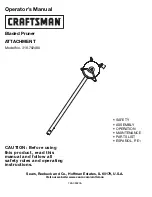
English
10" Compound Miter Saw
Operator’s Manual GMS1015LC
16
MITER CROSSCUTTING (FIG 22)
Crosscuts are cuts made across the grain of the work piece, with
a straight cut being made with the both the blade bevel and miter
table set at 0°. A miter crosscut is made when the miter table is set
at some angle other then 0°.
1. Measure and mark the work piece with the desired cut line.
Mark the work piece on each side of the cut line indicating
which side is the scrap or off cut and which the desired finished
piece is.
2. unlock the rotating miter table by loosening the miter locking
knob.
3. use the miter handle to rotate the table, left or right, to the
desired cutting angle. Then tighten the miter lock knob.
4. Place the work piece onto the saw table and against the fence.
Turn on the laser light source.
5. Move the work piece left or right to align the cut line with the
saw blade and laser light. Then secure the work piece in place,
holding it either by hand for large pieces or via the clamping
device for small pieces.
6. After confirming the saw settings and that the work piece is
secured, turn on the saw and make the cut.
BEVEL CUTTING (FIG 23)
A bevel cut is made by cutting across the work piece grain with the
blade angled or tilted to the work piece. When making a straight
bevel cut, the miter table is set at the 0° position and the blade
angled and set at a position between 0° and 45° left.
1. Measure and mark the workpiece with the desired cut line.
Mark the workpiece on each side of the cut line indicating
which side is the scrap or off cut and which the desired finished
piece is.
2. Set and lock the rotating miter table in place at 0°.
3. Loosen the bevel locking handle and move the cutting arm left
or right to the desired bevel angle as indicated by the bevel
scale pointer. Tighten the bevel locking handle securely.
4. Place the workpiece onto the saw table and against the fence.
Turn on the laser light source.
5. Move the workpiece left or right to align the cut line with the
saw blade and laser light. Then secure the work piece in place,
holding it either by hand or via clamping device.
6. After confirming the saw settings and that the workpiece is
secured, turn on the saw and make the cut.
COMPOUND MITER CUTTING (FIG 24)
A compound miter is a cut made using both a miter setting and blade bevel setting at the same time. This type of
cut is commonly used for picture framing, boxes with angled sides, roof framing cuts, and trim molding.
Compound miter settings are made up of miter and bevel angles that are interdependent, therefore, desired and
accurate cuts can be difficult to attain. When a miter angle is changed it affects the bevel angle setting and vice
versa. It may take numerous set-ups and test cuts to realize the desired outcome. When compound cuts are
required in projects, the settings are usually provided, taken from specialty manuals with pre-calculated settings,
published charts, etc. Also you may refer to
Cutting Compound Miters
chart included in this manual.
1. Set the bevel angle and miter angle as described earlier and lock the respective adjustment handles securely.
2. for the initial cuts, use scrap material for making test cuts to confirm that bevel and miter angles are set
correctly.
3. After confirming the bevel and miter settings are correct, make the compound miter cuts as described in the
previous separate sections for bevel and miter cuts.
FIG 22
FIG 23
FIG 24
















































